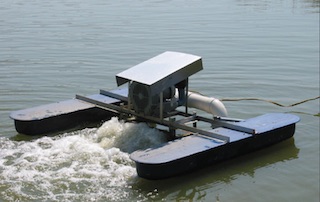
Think inside the box
August 11, 2015
By Matt Jones
 Stratification at a friend's pond led to Dr. William Wurts' most exciting work on airlift pumps.
Stratification at a friend's pond led to Dr. William Wurts' most exciting work on airlift pumps.“I’ve been playing with airlift pumps since before graduate school,” says Dr. William Wurts, Kentucky State University Professor and Senior State Specialist for Aquaculture. “My holy grail was pumping several hundred gallons.”
Wurts’ experience with inventing airlift pump technology led to him developing pumping systems for a variety of clients from a grocery store with a circulation problem in their seafood tank to a variety of ponds and hatcheries. But it was a problem with stratification at a friend’s pond that led to his most exciting work.
“In the summer, the top layer warms up much more than the bottom layer,” says Wurts. “You get this four foot layer of warm water that’s 10-15 degrees warmer than the water below it, so they’re not mixing. His water was murky and the problem with that is the bottom layer isn’t circulating to the top and if you don’t have aeration, you’re not getting oxygen to that lower layer. He could see fish come up for the pellets and you could see a little hole where they came up and then it would seal up.”
Wurts developed an air injection system for the pond utilizing a two horsepower air blower from a nearby processing plant. The first injector utilized irrigation hoses with a very fine pore – designed to shoot water out of them, but when used to pump air the result is very fine mists of bubbles coming out the length of the hose.
Wurts’ friend was apprehensive, however, raising concern that the living creatures and bacteria in the water would colonize the air tube and calcify the holes, which would block off the airflow. With the air holes blocked, the pressure will rise and the efficiency of the blower will drop rapidly. Luckily, Wurts approaches his pumps in the manner of an artist – constantly reinventing and evolving his work.
“As I was driving home, it struck me that we were doing it all wrong and that’s when I came up with the design we ended up using,” says Wurts.
The design is a single horizontal injector tube with large holes symmetrically on either side, inside where the water flow comes past the pipes, so the injection is not straight into the water flow.
“Think of a piece of Styrofoam,” says Wurts. “It’s plastic that as they push it through their mold, they use an expansion gas. As it moves through the gas expands. That’s what makes it become a foam – that’s what you’re getting, a lot of bubbles in a piece of plastic – an air-plastic mixture that is lighter than water. If you push it down into water, the surrounding water pushes it up – basic Archimedes. Let’s visualize an injector system like my horizontal system – they’re mixing with the water – and air-water system. The water in the environment you’re putting it into, pushes it up to the top of the riser housing. The air comes out and the water comes out of the top. What you’ve got is a continuous flow of air that produces a constant air-water mixture that creates a continuous flow of water.”
Systems similar to this have been in existence since the 1970’s, but the key difference in Wurts’ system is the rectangular shape. “It existed in 1973, but I built a better mouse trap,” says Wurts. “That’s what I came up with – I fixed the design for what I wanted. It would only cost you about $3.12 to circulate 3.8 million gallons of water a day.”
Thinking that this technology could be useful and possibly lucrative, Wurts sought to patent it but he found the patenting process to be extremely difficult to navigate as an independent party, describing it much like a poker game where your opponents have all the chips.
“There are lessons you know nothing about until you do it,” says Wurts. “It ended up being a $6,000 lesson in how patents work. After we abandoned the patent in June of 2012, I said ‘I’m not going to let anyone else patent this thing,’ so I started presenting it at conferences.”
Wurts has presented his concept at four conferences and entitled the presentation “Think Inside the Box” with the main purpose of finding a partner willing to use the technology. While the concept could be used for de-stratification and similar applications, Wurts remains unsure of where and how best to utilize the concept.
“My objective is to get maximum volume circulation with very low input energy, maximum output,” says Wurts. “The applications I see for it are circulating very high volumes of water with a very small horsepower unit. You can de-stratify a pond by running the airlift pump during the day. It lends itself well to using solar power, so you could run the pump during the day and you don’t need to during the evening, since the heat causes stratification. If I do that, though, everything becomes public knowledge. From my $6,000 patent seminar, I’m not going to put it out there until I have the funding to back it up.”
— Matt Jones
Advertisement
- Announcing the NOAA Aquaculture Photo Contest!
- MEMBERS OF GLOBAL SALMON INITIATIVE ANNOUNCE TENDER FOR NOVEL OIL SOURCES RICH IN OMEGA-3





